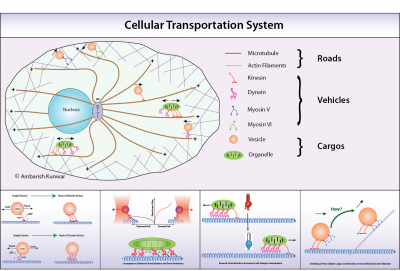
Cell is the basic unit of life and can be often compared to a city. Cities have power plants, cells have mitochondria. Cities have factories, cells have ribozymes and endoplasmic reticulum. Cities have depots and ware houses while cells have Golgi bodies. One of the most important aspects of the city without which it cannot sustain its operation is the transportation system i.e. roads, rails, trains and vehicles. Cells have a transportation system whereby microtubules and actin filaments form a network of roads. On these protein roads, vehicles called motor proteins carry various types of cargos such as vesicles and organelles. The motor proteins are mechano-chemical enzymes i.e. they use chemical energy derived from their fuel (ATP) to produce mechanical force. Therefore, function of these motor proteins can be altered by various means i.e. changing the fuel concentration, changing forces felt by them, changing temperature, etc. During various physiological processes a cargo is typically hauled by a team of motors. Our lab uses computational modeling constrained by experimental data to understand the transport by a team of either same type of motor proteins or by an antagonistic team of motor proteins. By using computational modeling we have studied how transport by a team of either Kinesin motor proteins or Dynein motor proteins changes due to change of fuel (ATP) concentrations. What are the advantages of anisotropic detachment kinetics for a team of motor proteins? Can the net direction of cargo transport be changed by changing the temperature? How do cargos switch from one filament to another at crossroads i.e. micrtobule- microtubule, actin-actin and microtubule-actin intersections inside cells, and how does this switch depend on properties of motor proteins, properties of microtubule / actin and properties of cargos- are some of the questions that we are trying to find answers for.
Prof. Ambarish Kunwar
